How to fix parallelled single line Panasonic Telephones that do not ring?
- RRyan BensonAug 27, 2025
If the parallelled single line telephones do not ring, the 'No ring' setting may be selected. Change the setting to ring.











How to fix parallelled single line Panasonic Telephones that do not ring?
If the parallelled single line telephones do not ring, the 'No ring' setting may be selected. Change the setting to ring.
How do I fix noise on external paging with my Panasonic PBX?
To eliminate noise on external paging with your Panasonic PBX: Use a shielded cable as the connection wire between the PBX and amplifier. A short shielded cable is recommended.
Why are my IP-PTs or SIP phones not operating on my Panasonic KX-NS1000 PBX?
If your IP-PTs or SIP phones aren't working with your Panasonic PBX, consider these potential causes: a malfunctioning DSP card (replace the card), a faulty motherboard (replace it after turning off the PBX), or not enough activation keys (purchase more from a certified dealer). Also, the IP-PT/SIP phone might not be registered (register it), or the phone itself may be faulty (replace it). Poor connection could be the issue; ensure you're using an 8-pin twisted pair cable, that CAT 5/CAT 5e cables are under 100m, and a straight cable connects to the switching hub. Lastly, a network malfunction could be the reason; ensure all network devices are on and the IP-PT/SIP phone isn't blocked by a firewall.
Why do the parallelled single line telephones not ring on my Panasonic Conference System?
If the parallelled single line telephones do not ring, 'No ring' may be selected. Change the setting to ring.
Why I cannot have a conversation using Bluetooth headset on my Panasonic Telephone?
To resolve the issue, ensure that: * The headset is properly registered to the module. * The headset is properly charged according to its manual. * The wired headset is removed from the headset jack, as priority is given to the wired headset when both are connected.
What to do if my Panasonic Telephone does not respond when buttons are pressed?
If your Panasonic Telephone is locked, it will not respond when buttons are pressed. Unlock your telephone.
I cannot send a call waiting tone to the dialled extension on my Panasonic Conference System - why?
The other party has not set the Call Waiting feature, or the other party has set Data Line Security.
Why I cannot use the secondary Ethernet port on Panasonic Conference System?
If you are using a KX-NT500 series telephone, check whether ECO mode is enabled. If it is enabled, ask your dealer to disable ECO mode.
Why can't I set the IP address, subnet mask address, and PBX IP address to the IP-PT on my Panasonic KX-NS1000 PBX?
If you're unable to set the IP address, subnet mask address, and PBX IP address to the IP-PT on your Panasonic PBX, it's likely because you are setting an unusable value. Ensure you set an IP address within the valid range. For the IP address of the IP-PT/PBX, use a value between "1.0.0.0" and "223.255.255.255". For the subnet mask address, use a value between "0–255.0–255.0–255.0–255", excluding "0.0.0.0" and "255.255.255.255".
What to do if the IP-PT cannot connect to the Panasonic KX-NS1000 PBX?
If your IP-PT cannot connect to the Panasonic PBX, several factors could be responsible. First, the IP address, subnet mask address, PBX IP address, or default gateway address may have been entered incorrectly; check each parameter and enter the correct value. Second, the Ethernet cable might not be connected properly; check the Ethernet cable connections. Third, the DHCP server may not be active; restart the external DHCP server, confirm whether the DHCP Server feature is enabled, or disable DHCP and re-enter settings as appropriate.
| Type | Hybrid IP-PBX |
|---|---|
| Max Concurrent Calls | 256 |
| VoIP Protocols | SIP, H.323 |
| Power Supply | AC 100-240V, 50/60Hz |
| Maximum Extensions | 1, 000 |
| IP Extensions | 1000 |
| Operating Temperature | 0°C to 40°C |
| Humidity | 10 to 90% (non-condensing) |
| Max Users | 1000 |
Describes the purpose and structure of the Feature Guide.
Outlines the main sections contained within the manual.
Provides details about safety precautions for preventing personal injury and/or damage to property.
Provides details about the call handling features.
Details the Unified Messaging system, including administration and features.
Explains features related to network connectivity and protocols.
Covers system configuration, extensions, and data control features.
Contains supplementary information such as system resources and revision history.
Provides an alphabetical listing of topics and their corresponding page numbers.
Details safety precautions for preventing personal injury and/or property damage.
Provides specific safety precautions and explains hazard symbols.
Covers features related to receiving incoming calls.
Details how incoming calls via trunks are distributed to destinations.
Provides automatic direction of incoming trunk calls to preprogrammed destinations.
Provides automatic direction of incoming calls with DID/DDI numbers to preprogrammed destinations.
Provides automatic direction of incoming ISDN-BRI line calls with an MSN to destinations.
Directs incoming calls to a CLI destination based on caller's identification number.
Provides automatic redirection of incoming trunk and intercom calls.
Provides automatic redirection of incoming trunk calls without an assigned destination.
Details features for calls between extensions within the PBX.
Lists the types of internal calls available, such as Intercom and Doorphone.
Restricts internal calls based on Class of Service (COS) destinations.
Describes methods used to indicate incoming calls.
Summarizes various incoming call indication methods like Ring Tone, LED, and Display.
Allows selection of ring tone patterns for different incoming call types.
Informs a busy extension that another incoming call is waiting.
Details features related to receiving calls via groups.
Redirects incoming calls to an idle member of a hunting group if the primary extension is busy/DND.
Covers features for managing incoming calls distributed to a group of extensions.
Summarizes Incoming Call Distribution (ICD) groups and their management.
Distributes incoming calls to member extensions using methods like UCD, Priority Hunting, or Ring.
Allows calls to wait in a queue when extensions in a group are busy.
Assigns priority to incoming call distribution groups for preferential call handling.
Redirects calls to a preprogrammed destination or sends a busy tone when queue capacity is exceeded.
Allows members to join (Log-in) or leave (Log-out) the group manually.
Allows a supervisor extension to monitor and control member status within an ICD group.
Covers features for forwarding or refusing calls when an extension user is unavailable.
Summarizes Call Forwarding (FWD) and Do Not Disturb (DND) features.
Allows extensions and ICD groups to forward calls to preset destinations.
Allows an extension user to set DND, preventing calls from arriving at the extension.
Displays FWD/DND status and allows temporary setting or cancellation.
Describes methods an extension user can use to answer incoming calls.
Summarizes answering methods like Line Preference and Hands-free Answerback.
Allows PT users to select the method for answering incoming calls.
Enables an extension user to answer a call ringing at any other extension.
Allows a PT user to talk to a caller without lifting the handset.
Details features for making calls.
Allows a display PT user to check and correct a number before dialling.
Releases an extension automatically if no digits are dialled within a programmed time.
Allows an extension user to call another extension user.
Covers features available when making a trunk call.
Summarizes features for trunk calls like Emergency Call and Account Code Entry.
Allows dialing preprogrammed emergency numbers regardless of restrictions.
Allows entering an account code to identify outgoing calls for accounting purposes.
Allows selection of dial mode (rotary or tone) for analogue trunks.
Detects reverse signals from the telephone company for trunk call status.
Monitors loop current on analogue trunks to prevent seizing trunks with no loop current.
Inserts a preprogrammed pause time between digits of a dialled number.
Allows a behind PBX to access the telephone company through a host PBX.
Assigns a code for accessing multiple telephone companies for trunk calls.
Covers methods for selecting the line seized for making calls.
Summarizes line seizing methods like Line Preference and Trunk Access.
Allows PT users to select the outgoing line they prefer when going off-hook.
Describes methods used to access a trunk.
Details features for storing and dialling numbers quickly.
Summarizes memory dialling features like One-touch Dialling and Speed Dialling.
Allows accessing a person or feature by pressing a single button.
Automatically saves recently dialled numbers for easy redialing.
Allows making calls using abbreviated dialling for frequently used numbers.
Allows accessing an extension or feature by simply dialling a Quick Dialling number.
Sets an extension to automatically dial a preprogrammed number when going off-hook.
Covers features to prohibit or restrict extension users from making certain trunk calls.
Prohibits extension users from making certain trunk calls by COS programming.
Limits telephone usage to a preprogrammed budget on an extension basis.
Allows users to change TRS/Barring levels to prevent inappropriate trunk calls.
Allows managers to temporarily change TRS/Barring levels for extension users.
Allows users to use their COS at another extension, overriding the other extension's COS.
Identifies calls for accounting/billing or changes TRS/Barring level using a verification code.
Details how ARS automatically selects carriers for outgoing trunk calls.
Automatically selects the carrier available at the time of an outgoing trunk call.
Provides features for PDN and SDN buttons, ideal for boss-secretary communication.
Details PDN and SDN buttons for boss-secretary communication.
Covers features for handling calls when extensions or lines are busy.
Monitors a busy destination/trunk and sends a callback ringing when available.
Allows an extension user to interrupt an existing call to establish a three-party conference.
Allows an extension user to listen to a busy extension user's existing conversation.
Notifies a busy extension of a second incoming call.
Summarizes Call Waiting, OHCA, and Whisper OHCA notifications.
Sends a Call Waiting tone to a called extension to indicate another call is waiting.
Allows talking with a busy extension via speaker/microphone without lifting handset.
Sends a spoken message to a busy extension heard only by the called user.
Details features related to conversations.
Allows a PT user to talk without lifting the handset.
Allows others to listen to a conversation through the built-in speaker.
Allows disabling the speaker or handset microphone for private consultation.
Allows the use of headset-compatible PTs for talking without lifting the handset.
Protects communications from interruptions by signals like Call Waiting.
Features for disconnecting a call and originating another without hanging up.
Allows users to access features outside the PBX using telephone company services.
Limits trunk call duration by system timer.
Detects CPC signal from analogue trunks to monitor status and disconnect lines.
Covers features for transferring calls.
Allows an extension user to transfer a call to another extension or an outside party.
Details features for placing calls on hold.
Allows an extension user to put a call on hold.
Allows placing a call into a common parking zone for later retrieval.
Allows calling another extension while putting the original party on Consultation Hold.
Plays music to a party that has been put on hold.
Details features for establishing conference calls.
Summarizes features for establishing conference calls.
Allows adding additional parties to an existing two-party conversation.
Allows suspending Automatic Privacy to join a three-party call.
Covers features for group conference calling.
Allows calling a pre-determined group simultaneously for conference calls.
Details features for accessing PBX functions via an SLT extension.
Allows outside callers to access specific PBX features like intercom calls or outside calls.
Automatically transfers fax calls arriving on DISA lines to preprogrammed destinations.
Covers features for making voice announcements.
Allows an extension user to make a voice announcement to multiple destinations.
Allows any extension user to answer a call received at the floating extension number.
Details features for connecting and controlling external devices.
Allows connecting doorphones to the PBX for visitor communication.
Allows an extension user to unlock a door for a visitor using their telephone.
Connects external sensing devices to the PBX for alerting.
Allows the PBX to control external devices like alarms via relays.
Covers features for receiving and displaying caller information.
Receives caller information such as name and number through the trunk.
Automatically records caller information in the call log of the called extension.
Details features related to messages.
Notifies subscribers of new messages via telephone lamps or displays.
Allows users to set or select a message to be displayed on their telephone.
Describes the hardware features of PTs.
Details the usage of fixed buttons on PTs, DSS Consoles, and Add-on Key Modules.
Explains how flexible and programmable feature (PF) buttons can be customized.
Describes how LEDs on buttons show line conditions with various light patterns.
Details the information displayed to the user during calls.
Covers features for administrative tasks and information logging.
Details features for recording call information.
Automatically records detailed information for each extension.
Outputs local alarm information to an external PC via a Syslog server.
Allows selecting messages to be output on SMDR.
Provides call charge information and services.
Covers features supporting hotel-type environments.
Summarizes features for hotel environments like Room Status and Call Billing.
Allows hotel operators to view and set room check-in/check-out/cleaned status.
Outputs call records with charges for guest billing.
Details features for controlling extension behavior and access.
Allows users to set features or access their telephone remotely using a PIN.
Allows users to clear multiple features set on their telephone at once.
Covers features for using extension settings at different locations.
Allows using any extension with your settings available, known as Walking Station.
Allows setting a reminder or wake-up call at a certain time.
Details distinctive dial tones that inform extensions about activated features.
Describes distinctive dial tones informing extensions about activated features.
Confirms feature operation success by sending a tone to extension users.
Covers CTI interface features for advanced call handling.
Allows extension users to make/receive calls with advanced features via LAN.
Details the CA CTI application and its operating modes.
Provides features for using cellular phones and other outside destinations with the PBX.
Summarizes features for cellular phones and other outside destinations.
Covers various miscellaneous features.
Allows PT users to listen to BGM through the built-in speaker.
Allows manager extensions to record outgoing messages for various features.
Covers administration of the Unified Messaging system.
Provides an overview of the Unified Messaging system's features and users.
Details system administration tasks for the Unified Messaging system.
Allows clearing subscriber passwords for new assignments.
Allows backing up or restoring system data as individual files.
Provides system reports for monitoring operating status.
Protects the Unified Messaging system from unauthorized programming or use.
Details the PBX's ability to receive, distribute, and send faxes.
Covers system features and subscriber-specific mailbox customizations.
Details system-level features within the Unified Messaging system.
Allows callers to perform specific functions by pressing dial buttons.
Details features that subscribers can use to customize their mailboxes.
Allows subscribers to receive a message confirming reception of sent messages.
Automatically forwards received faxes to a specified fax machine.
Allows subscribers/managers to log in to mailboxes directly without entering mailbox number.
Plays new messages automatically when a subscriber logs into their mailbox.
Enables setting a bookmark per message while pausing a message.
Allows subscribers to make outside calls via the subscriber service menu.
Creates a call handling scenario by combining Call Transfer and Incomplete Call Handling.
Allows subscribers to specify how the UM system handles calls to their extensions.
Enables callers to leave a callback number in various ways.
Enables subscribers to call back a message sender using the Caller ID number.
Requests confirmation from subscriber before erasing a message.
Allows subscribers to access features directly by dialling a UM extension number.
Allows subscribers to send messages to multiple parties at a specified time.
Adds a cover page to a fax before it is sent.
Allows subscribers to send faxes from their computer using the standard print function.
Forwards calls to the floating extension number of the UM group to the extension's mailbox.
Allows sending messages to multiple mailboxes simultaneously.
Offers callers service options when the extension is busy or no answer.
Allows subscribers to monitor incoming calls as messages are being recorded.
A place where all messages left for a subscriber are stored.
Alerts subscribers when recording time for mailboxes is running low.
Allows subscribers to access System Manager's and Message Manager's mailboxes.
Allows subscribers to transfer messages to other mailboxes after listening.
Allows subscribers to use Custom Services in their Personal Greeting.
Describes greetings heard when a caller reaches a subscriber's mailbox.
Allows subscribers/managers to mark messages as 'Private'.
Enables subscribers to recover deleted messages.
Allows subscribers to change their absent message from a remote location.
Allows subscribers/managers to program extensions from remote locations.
Allows subscribers to send received faxes to another destination.
Provides voice guidance for first-time mailbox login and configuration.
Allows subscribers to set a Timed Reminder by following system prompts.
Allows checking mailboxes without incurring telephone charges.
Provides features for recording conversations for subscribers.
Allows specifying a message as 'Urgent' for priority playback.
Allows subscribers to transfer calls to mailboxes by pressing the VM Transfer button.
Allows subscribers to access and change various settings via Web Maintenance Console.
Covers features related to public network connections.
Connects to Internet telephony services provided by an ITSP using SIP.
Details ISDN features for voice, data, and image transmission.
Summarizes ISDN interface types and supplementary services.
Sends caller/answered party number/name to QSIG network.
Receives call charge information on ISDN lines from the telephone company.
Forwards incoming ISDN calls to another outside party via telephone company.
Forwards incoming ISDN calls directly to the network destination.
Puts an ISDN call on hold using the ISDN service of the telephone company.
Transfers an ISDN call to an outside party using ISDN service.
Establishes a three-party conference call using ISDN service.
Allows tracing a malicious caller during a call or after hang-up.
Receives callback ringing when a called party becomes free.
Provides supplementary services via key protocol, possibly requiring a service access code.
Details connecting and managing multiple PBXs over a private IP network.
Provides an overview of One-look networking, including Master/Slave units.
Compares One-look networking with H.323 QSIG networking.
Covers features ensuring network operation during failures.
Details modes for maintaining operation when the Master unit fails.
Allows IP extensions to automatically reconnect to a secondary PBX if the primary fails.
Redirects calls to another PBX's UM group if the primary UM group is unavailable.
Covers features for establishing private networks.
Provides cost-effective communications between PBXs at different locations via leased lines.
Describes two methods for making a TIE line call.
Details patterns for connecting TIE lines with trunks.
Explains how to route calls to the TIE line.
Details the system programming for TIE line calls.
Describes trunk calls through other PBXs using the ARS feature.
Explains how to block and override trunk calls through another PBX.
Provides programming examples for PBX-2.
Provides programming examples for PBX-1 and PBX-2.
Provides programming examples for PBX-1 and PBX-2 with SMDR output.
Shows an example of call routing to the trunk via TIE line.
Connects an outside caller to an outside party through TIE line using DISA feature.
Details TIE Line Routing and Modification Table for programming.
Provides programming examples for PBX-1's TIE Line Routing.
Provides programming examples for PBX-1's TIE Line Routing.
Illustrates receiving a call through a TIE line using Extension Number Method.
Illustrates receiving a call through a TIE line using PBX Code Method.
Flowchart for making a TIE Line call from an extension.
Illustrates receiving a call through a TIE Line.
Provides PC Programming Manual References for TIE Line Service.
Describes ISDN VPN service using existing lines for private network communication.
Details ISDN VPN service usage and public/private discrimination.
Covers standard QSIG protocol features for PBX communication.
Summarizes standard QSIG features like CLIP, COLP, CLIR, COLR.
Sends caller/answered party number/name to QSIG network.
Forwards a call to the QSIG network.
Transfers a call to the QSIG network.
Receives callback ringing when a busy called party on QSIG network becomes free.
Details enhanced features for PBXs networked via ISDN or V-IPGW cards.
Assigns flexible buttons to monitor extension status on other PBXs.
Details NDSS button functions and network PBX ID assignment.
Explains NDSS feature conditions and programming.
Allows multiple PBXs to share Unified Messaging services.
Covers features for ICD groups across multiple PBXs in a private network.
Allows PS registration across multiple PBXs for simultaneous calls.
Covers system-wide configuration settings.
Controls behavior and privileges of extension users by assigning a COS.
Details various group types like Trunk, Extension User, Call Pickup, and Paging.
Allows sharing the PBX with a certain number of tenants.
Supports day, night, lunch, and break modes for call routing.
Details features for assigning and managing operators.
Covers features accessible to extensions assigned as managers.
Covers configuration for different types of extensions.
Details IP telephones that connect to the PBX over a LAN.
Supports SIP-compatible IP telephones for making and receiving calls.
Describes features available on KX-UT series SIP phones.
Explains features available to SIP-CSs and S-PSs.
Supports simple remote connectivity for SIP phones via SBC.
Establishes direct communication between compatible IP extensions.
Covers features for Portable Stations (PS).
Describes connecting PSs and using PBX features with PSs.
Defines a group of PS extensions that receive incoming calls.
Allows PS users to store and dial numbers from directories.
Describes customizing flexible buttons on PSs for PBX features.
Allows using a PS in parallel with a wired telephone.
Assigns an extension number to a portable station without registering the PS unit itself.
Covers features for ISDN extensions.
Details how ISDN ports can be used for trunk or extension connection.
Covers connecting legacy devices not natively compatible with KX-NS1000.
Details connecting PBXs via a stacking connection to act as a legacy gateway.
Connects IP trunks to Trunk Adaptors for E1/PRI line connections.
Covers features for notifying users via e-mail about events.
Notifies extension users via e-mail about events like new messages or missed calls.
Sends e-mails to administrators about system-level events like alarms or software updates.
Covers management of user information and system data.
Manages user information settings on a per-user level.
Details the three levels of authorization for programming the PBX.
Allows PT users to perform personal or manager programming.
Explains DSP resource requirements for PBX operations.
Allows reserving DSP resources for specific features to guarantee minimum performance.
Provides a tool to calculate required DSP resources based on operating conditions.
Features for automatic ISDN configuration and time adjustment.
Provides automatic IP address assignment to network devices.
Details numbering plans for dialing extensions and accessing PBX features.
Allows assigning virtual extension numbers to resources.
Procedures for updating PBX software and connected device software.
Covers features for fault recovery and system diagnostics.
Details integrating UPS for power failure protection.
Automatically connects specific SLTs to trunks during power failure.
Describes how the PBX restarts stored data after power restoration.
Provides information on PBX errors and alarm status.
Allows managing PBX status information using SNMP.
Assigns the PBX as a DHCP client for automatic IP address assignment.
Confirms connection of IP telephones, routers, and hubs using PING.
Lists the capacity limits for various PBX features and resources.
Details the default tone patterns for various call indications.
Illustrates default tone patterns for confirmation, dial, busy, and ringback tones.
Lists features that require specific activation keys.
Provides a table of supported MIB objects for SNMP management.
Lists software file versions and changes made.
Details new and changed contents for software file version 002.0xxxx.
Lists new and changed contents for software file version 002.1xxxx.



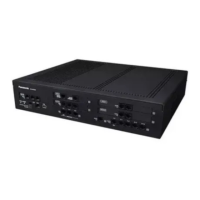



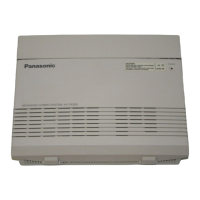
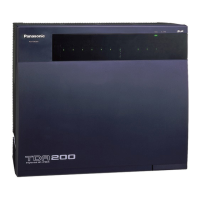
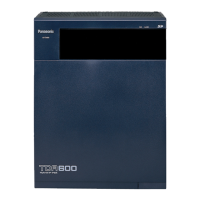
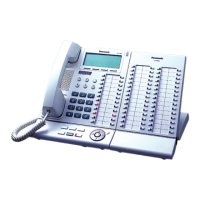
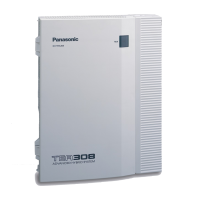
